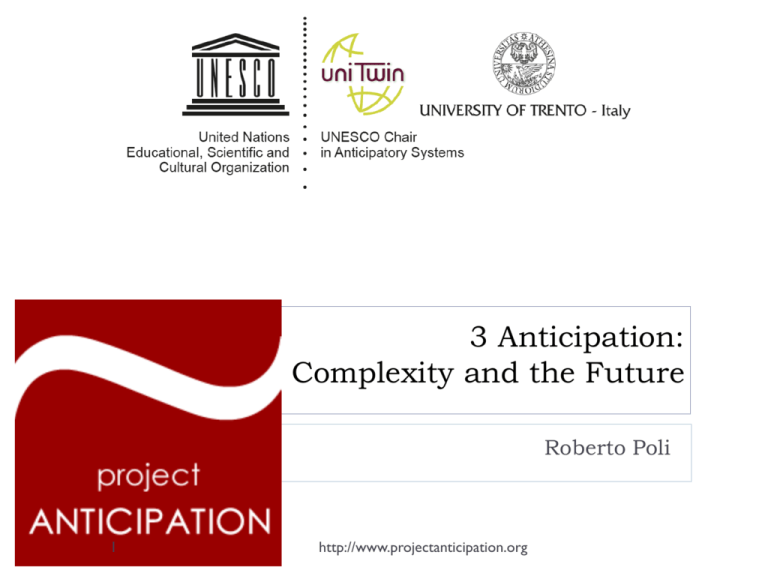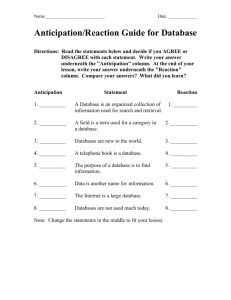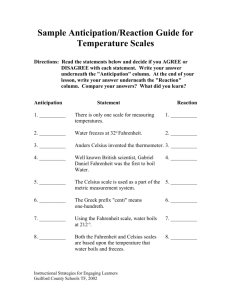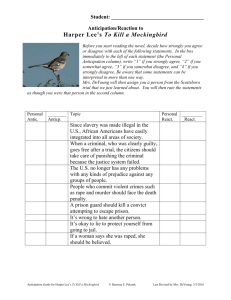PPT - World Academy of Art and Science
advertisement

3 Anticipation: Complexity and the Future Roberto Poli 1 http://www.projectanticipation.org Discipline of Anticipation Use the future to reshape the human and social sciences As a matter of fact all human and social sciences have accepted, to varying extents, what is possibly Newton’s most important implicit assumption, what Rosen called the Zeroth Commandment: “Thou shalt not allow the future to affect the present” (Rosen 1991, 49) The Zeroth Commandment implies that all information comes from the past and no information comes from the future The idea that at least some information may derive from the future is the source of the theory of anticipatory systems 2 http://www.projectanticipation.org Future information At a first sight, the expression “information that is coming from the future” appears implausible, unless one reads the expression “coming from the future” as concerning information conveyed by a model of the system “Model” here is a shorthand for a variety of situations including theory, idea, guess, belief, hope and fear All them convey information on the future Models can be explicit or implicit 3 Theories and ideas are usually explicit Beliefs, hopes and fears are either explicit or implicit http://www.projectanticipation.org What is an Anticipatory System? Rosen: “An anticipatory system is a system containing a predictive model of itself and/or its environment, which allows it to change state at an instant in accord with the model’s predictions pertaining to a later instant.” A deceptively simple definition … Models “enable us to pull the future into the present” Models (theories, etc.) are explicitly or implicitly used to anticipate relevant situations (hopes and fears may work implicitly, i.e. below the subject’s threshold of awareness) System S + lattice of its models 4 A maximal model exists s.t. all the models of S are included in the maximal model as particular cases (the lattice of models admits Top) A maximal model does not exists (the lattice of models is without Top) http://www.projectanticipation.org Anticipatory system We speak of anticipatory systems when the model(s) are embedded within the system The same (anticipatory) system may (and usually do) contain a multiplicity of models which may influence each other in forms that are still little understood 5 How implicit models influence explicit ones? http://www.projectanticipation.org Science By further developing this train of thought, one arrives at an idea of science more general than any of the competing mainstream acceptance of science presently available Instead of distinguishing between the Queen (physics) and the pawns (all the rest), the new vision distinguishes between the general framework underlying all sciences (what Rosen called the modeling relation) and a variety of different realizations of that framework Each realization depends on specific constraints On this view, physics is a highly specific – that is, non-generic – science, while other sciences, notably biology and all the sciences that rely on it (i.e. all the human and social sciences), will require less demanding constraints (go back to my first lecture) 6 http://www.projectanticipation.org Anticipation Widely different ideas of anticipation So far, no systematic comparison among the various proposals has ever been tried We literally do not know whether the same idea has been discovered times and again or entirely different perspectives have been proposed For a preliminary analysis: R. Poli, “The many aspects of anticipation”. Foresight, 2010, 12(3), pp. 7–17. ≈100-page (partial and, well, biased) bibliography: M. Nadin, “Annotated Bibliography Anticipation”. International Journal of General Systems, 2010, 39(1), pp. 35–133. 7 http://www.projectanticipation.org Some Questions about Anticipation • When anticipation does occur in behaviour and life? • What types of anticipation can be distinguished? • Which properties of our environment change the pertinence of different types of anticipation? • Which structures and processes are necessary for anticipatory action? • Which is the behavioral impact of anticipation? • How can anticipation be modeled? 8 http://www.projectanticipation.org Two perspectives The traditional saying: use the past to understand the present (historia magistra vitae) The new vision: use the future to understand the present (= anticipation) Past 9 Present http://www.projectanticipation.org Future Caveat! These two perspective aren’t orthogonal – one can, and should, use both To make sense, the present can’t be seen as an extensionless boundary between the past and the future (thick against thin present) Similarly, the future should be seen as a force, on a par with the past Past 10 Present http://www.projectanticipation.org Future Problem The Zeroth Comandment “Thou shalt not allow the future to affect the present” By giving full scientific legitimacy to the future, a remarkably new vision of science arises – including a fully scientific (i.e., not allusive, metaphorical or mystical) treatment of ‘final’ causation (= anticipation) Here I will follow a pretty prudential/conservative route – even so, you will see that many surprises are in store 11 http://www.projectanticipation.org The main question Why do we study the future? – to take better decisions today Not only: use the past to understand the present, but also: use the future to understand the present The present – where the forces of the past and future meet Thick against thin understanding of the present If we are blind to the future, we fail to understand the present And we fail to see that the present is already future-bound 12 No action can berformed without a future component – even as simple an action as to go out to buy some bread involves the future Similarly, no decision, no project, no plan can be devised without involving some stretch of the future (here and now, in the present) “… via intentional agency, the present is always futurized, i.e., the future is always present in the moment of action” (Patomaki 2011) http://www.projectanticipation.org Futures Individual determinants: Hopes, fears, attitudes, goals, projects Contextual determinants: STEEP (Social, Technological, Economical, Ecological, Political) At different levels of depth: CLA (Litany, Social causation, Legal, Worldview, Myth) Valorial The number of levels is immaterial (Inayatullah distinguishes 4, Gurvitsch 10, for most exercises 3 are enough) What matters is that (1) lower levels constrain higher levels, and (2) lower (social) levels typically have slower rhythms 13 http://www.projectanticipation.org Attitudes towards the future Futures as cognitive attitudes (= imaginative or emotional) Futures as volitions (= plan, prepare for known contingencies) The dominant form of anticipatory activity in western societies Futures as ongoing processes in a state of latency, which eventually surface and become actual facts (= science) Futures as something that can be generated and/or consumed in the present 14 http://www.projectanticipation.org Futures Distinction between The future as seen, expected, imagined, hoped for or feared from the present The future as planned from the present The future as what is in the making but has still not surfaced The future as something we now “enlarge” or “shrink” There is a major difference between the first three cases and the fourth. In the former cases the future is “over there”, while in the latter case the future is the actual product of our deeds – which implies that strictly speaking the future is not over there, it is here and now 15 ≈ resilience http://www.projectanticipation.org Understanding the Present: Thin vs. Thick Past (from – to 0) Future (from 0 to +) Time Present (0) Thin present: The present as a boundary without any extension between past and future (≈ a mathematical point) Nothing real can unfold in no time Eventually, the present can be taken as the frontier where the past and the future meet each other Again, however, the interaction between past and future makes sense only if the present is thick, if it takes some time Distinguish mathematical idealizations from phenomenological analyses 16 http://www.projectanticipation.org Understading the Present: Thin vs. Thick Past Future Time Present Thick present 17 The present takes time (requires, consumes, generates time) Present as the collection of (almost) contemporaneous events http://www.projectanticipation.org The Multiplicity of the Presents Clock/calendar kind of time Mechanical No internal rythms (flows regularly at the same pace) Good at coordinating activities (agendas) Good intensificator of activities (agendas, again) Good at coordinating other times/presents (a kind of exchange currency) Biological—psychological—social times 18 Clusters of rythms, flowing at different paces http://www.projectanticipation.org Biological-psychological-social presents Psychological Present Duration? (700 s ca) Laws? (variable length, focus-periphery, constrained complexity, similarity, etc) Biological Present Duration? Laws? ? Social Present Duration? Laws? Shall we assume that the biological present, the psychological present and the social present do follow similar laws? 19 http://www.projectanticipation.org Contemporaneity The psychological present marks what is experienced as contemporaneous Shall we assume that the biological and the social present are similarly characterized by what is experienced as contemporaneous? “Who” (or “what”) is the perceiver? The cell/organism? – the group/organization/institution? Different social presents: 20 Economic Political What is contemporaneous from a(n) Institutional p.o.v. Behavioral Legal … http://www.projectanticipation.org Social present Each social present has its own typical duration From the point of view of objective time, what is behaviorally contemporaneous (e.g., fashion) may last for a few months, while some type of political contemporaneity may require years (e.g., legislation) Each kind of contemporaneity depends on some reference “object” (fashion, legislation) The reference object contributes to/shapes the internal working of its type of contemporaneity Extensive works are needed in order to find and list the laws of the various types of contemporaneity 21 http://www.projectanticipation.org When projected on coordinating time, all these contemporaneities are embedded one into another Psychological Social Biological (External) time 22 http://www.projectanticipation.org Time as the external semantics of ontologically different chronoids Coming back Why do we study the future? – to take better decisions today Not only: use the past to understand the present, but also: use the future to understand the present The present – where the forces of the past and future meet Thick against thin understanding of the present If we are blind to the future, we fail to understand the present And we fail to see that the present is already future-bounded 23 No action can berformed without a future component – even as simple an action as to go out to buy some bread involves the future Similarly, no decision, no project, no plan can be devised without involving some stretch of the future (here and now, in the present) “… via intentional agency, the present is always futurized, i.e., the future is always present in the moment of action” (Patomaki 2011) http://www.projectanticipation.org However Why the future is so easily discounted? There are many reasons for discounting the future. One is: “The End of History Illusion” (Science, 4 Jan 2013, vol. 339, pp. 96-98) Extensive survey (19,000 people, aged 18-68) “Young people, middle-aged people, and older people all believed they had changed a lot in the past but would change relatively little in the future.” “People, it seems, regard the present as a watershed moment at which they have finally become the person they will be for the rest of their lives.” 10 years ago I was very different from the person I am now – At the end of the next 10 years I will be the same person I am now The illusion leads “people to overpay for future opportunities to indulge their current preferences.” 24 http://www.projectanticipation.org So, What Can Be Done? The first step, preliminary to any other more nuanced strategy is to allow ourselves to talk about our future Literally, to give us permission to talk about our future, to insert the future into our present This preliminary step is far more difficult than it may appear 25 Because it is unusual – there are very few situations in which one can legitimately talk about her future Because one does not know how to do it http://www.projectanticipation.org A Difficult Step The first exercise I give to my students, at the end of the first lecture, is the following: project yourself ten years forward from now; you will have finished your studies, will likely have a job and a family. Imagine to write a letter to a friend of yours and to inform her about your life, what you are doing, etc. Most of the students find this exercise very difficult – and for the most part they write highly trivial letters However, the exercise is helpful because it alerts them that they do not know how to think about the future 26 http://www.projectanticipation.org Futures Literacy Allowing ourselves the right to talk about our future raises the problem of futures literacy: how can we become fluent in our future exercises? How can we make explicit the primarily implict future orientation of the present? As with reading and writing, futures literacy entails the capacity to understand as well as design explicit processes of anticipatory knowledge creation, as a necessary and ordinary skill (Miller) Futures literacy involves the acquisition of the know-how required to “make visible” and “use the future” appropriately Learn to distinguish 27 different kinds of future different ways of using the future http://www.projectanticipation.org Kinds of future Possible Probable Preferable A well-known classification Futurists know that the most probable future is the future that most likely will not become real For this reason we try to visualize a range of possible futures Moreover, since the future is “where we will spend the rest of our life”, the quality of the future (e.g., whether we like or dislike it) becomes important 28 http://www.projectanticipation.org Ways of using the future Concerning explicit anticipation, three main uses can be distinguished (Miller): Optimization: How to “colonize” the future (e.g., through planning) Contingency: How to prepare for anticipated surprises The dominant forms of anticipatory activity in western societies Novelty: How to expand perceptions of the present (beyond the constrains required by optimization and contingency) 29 http://www.projectanticipation.org A Step Further Optimization – One future, separated from the now (going towards the future) Contingency – More than one future, separated from the present (the future is coming upon me – from either a detectable or not detectable direction) Focus on visible, relevant, perceived aspects – I see where the future is coming from Focus on less or not visible, aspects – I have no idea where the future is coming from (I see that something is arriving but have no idea where it comes from) Novelty – The future is in the present (The future is now) Focus on next step – Incremental innovation Focus on final result – planning (linear, statistical, etc.) Focus on ideas (concepts, values) Focus on practices (behaviors, feelings, learning) Note: different contingent futures cannot be linearly arranged. This implies that contingent futures are not optimizable from within the point of view of contingency. Their optimization requires a decision, a choice, a shift, or a change of attitude (from contingency to optimization) Novelty may be such that one is capable of making sense of it only afterwards 30 http://www.projectanticipation.org Three levels (Tuomi) Forecasting – Previsive activity. Works well with pretty short (econometry) and very long (climate change) temporal windows Foresight 1.0 – Traditional Futures Studies (FS). Not previsive. Strong practical orientation, little theory. Poor acceptation of complexity Foresight 2.0 – Discipline of Anticipation (DoA) – not previsive – More balanced interplay between theory and practice – Futures Literacy. Complexity-based 31 http://www.projectanticipation.org Needless to say, I have only scratched the surface of the problem of anticipation – and only from a specific point of view However, I hope I conveyed you the idea that the future can be “studied” and “used” as seriously as any other subject Thank you for your attention 32 http://www.projectanticipation.org





